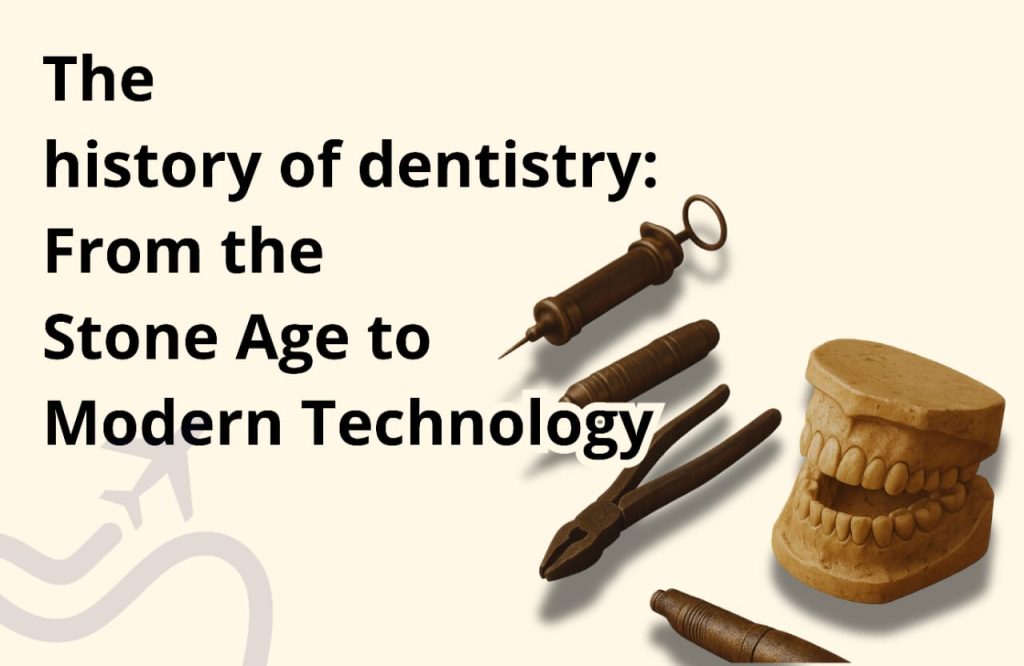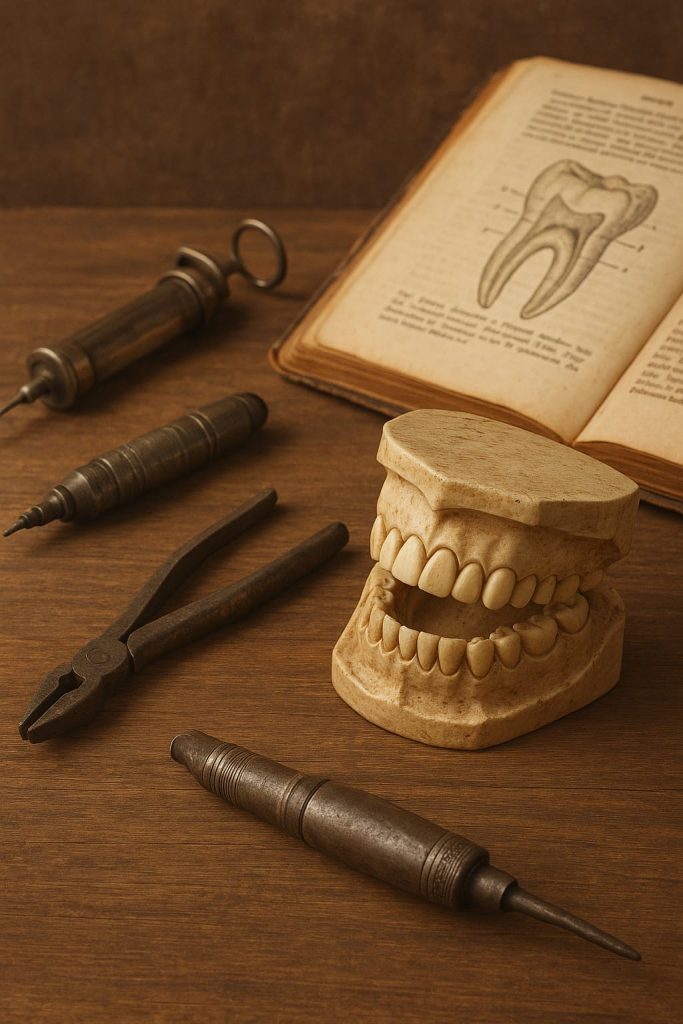The History of Dentistry: From the Stone Age to Modern Technology

Dentistry today is a high-tech blend of science and art, combining aesthetics, surgery, prosthetics, and preventive care. But it hasn’t always been this way. The journey dentistry has taken from ancient times to the present is fascinating and full of curious facts.
In this article, we’ll explore how people treated teeth thousands of years ago, when the first dental prosthetics and fillings appeared, and how technology has transformed oral health care.
- Stone Age: The First Attempts at Dental Treatment
Archaeological finds show that dental care existed tens of thousands of years ago.
The oldest evidence of dentistry was found in Italy: in a human jaw dating back about 14,000 years, traces of tooth drilling with a flint tool were discovered.
In ancient times, the main problems were cavities and toothache, and “treatment” often meant removing the damaged area using sharp stones or bones.
In the Neolithic period (7,000–5,000 BC), archaeologists found skulls with signs of dental interventions.
- Ancient Egypt: The Origins of Professional Dentistry
In Egypt, around 3000 BC, there were the first recognized “tooth doctors.” Their profession was respected, and some names have survived — for example, Hesy-Ra, considered one of the first dentists in history.
Egyptians used chalk, pumice, honey, and resin to clean and strengthen teeth.
They attempted to make dental prosthetics from wood, bone, and gold.
Inflammations were treated with herbal rinses, and in cases of severe pain, the tooth was extracted.
- Ancient India, China, and Mesopotamia: Dental Magic and the First Tools
In India, around 2000 BC, doctors used metal instruments for cleaning and extracting teeth, and they treated gums with herbal remedies.
In China, acupuncture was used to relieve toothache, along with ginseng and ginger decoctions.
In Mesopotamia, it was believed that cavities were caused by a “tooth worm” — a myth that persisted in many cultures for thousands of years.
- Ancient Rome and Greece: From Medicine to Aesthetics
The Greeks and Romans made significant contributions to the development of dentistry:
Hippocrates described methods for stabilizing teeth and removing decayed tissue.
Romans used gold wires to secure loose teeth and prosthetics.
Roman women whitened their teeth with a mixture of ash and herbs (unfortunately harmful to enamel).
The first dental forceps made of metal appeared.
- The Middle Ages: Decline and Barber-Dentists
After the fall of the Roman Empire, medicine in Europe stagnated.
Tooth treatments were often performed by barber-surgeons — the same people who cut hair and shaved beards.
The main method of treatment was tooth extraction.
Tools included pliers-like forceps and primitive hand-cranked drills.
Prosthetics were made from wood, ivory, or animal bone.
- The Renaissance: Science Returns
In the 16th–17th centuries, dentistry once again became part of official medicine.
French surgeon Ambroise Paré described methods of tooth extraction and smile restoration with prosthetics.
Better materials appeared — porcelain, gold, silver.
Techniques for securing teeth with metal arches developed.
- The 19th Century: The Birth of Modern Dentistry
The 19th century marked a turning point:
The pedal-powered drill (1864) allowed more precise cavity treatment.
Anesthetics appeared — first nitrous oxide (laughing gas), then novocaine.
Vulcanization of rubber was discovered, making prosthetics more affordable.
Dental schools opened — the first in the USA in 1840.
- The 20th–21st Centuries: High-Tech Dentistry
Today, dentistry integrates surgery, orthopedics, orthodontics, implantology, and aesthetics.
Lasers treat cavities and gums painlessly.
Digital 3D scanning replaces traditional impressions.
Implantology has restored millions of smiles worldwide.
Clear aligners offer an alternative to braces.
Regenerative dentistry is already testing the growth of teeth from stem cells.
- Dentistry in Azerbaijan: From Tradition to Global Standards
Azerbaijani dentistry developed actively during the Soviet era and now meets international standards:
Modern clinics like Dr.Baku use the latest equipment.
Dentists train and get certified abroad.
Dental tourism is growing — patients from Europe, the USA, Israel, and the Gulf countries come to Baku for full-service treatment.
Fun Facts from the History of Dentistry
The first known filling, made from beeswax, was found in Slovenia — over 6,500 years old.
George Washington wore a denture made from walrus ivory, human teeth, and gold.
In Ancient Rome, tooth powder was sometimes made from crushed mice (!).
In the 19th century, “toothache” was treated by applying leeches to the gums.

Conclusion
The history of dentistry is a story of humanity’s pursuit of health, beauty, and comfort. From stone tools to 3D prosthetics, the progress is astounding. Today, by visiting Dr.Baku, you can get results that ancient “tooth doctors” couldn’t have imagined.
📞 Book a consultation at Dr.Baku and become part of modern dental history!
